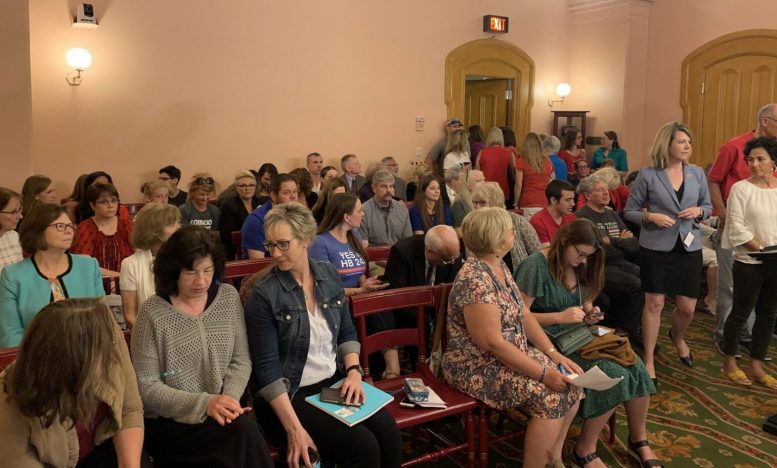A doctor warned that vaccinated people might be magnetized and pose a health risk to unvaccinated people around them.
A pastor said vaccines contain ingredients like formaldehyde and fetal cells.
A nurse sought to prove the truth of “magnetic vaccine crystals.”
These statements — none of which are true — came during the Ohio House Health Committee’s review Tuesday of House Bill 248, a broad weakening of state vaccination laws. The five-hour hearing, limited to proponent testimony, devolved into a forum of fear-stoking, speculation, and conspiracy theorizing around the COVID-19 vaccines.
Dr. Sherri Tenpenny, a board-certified physician from the Cleveland area, repeatedly raised unfounded claims of deaths, strokes and other “horrendous side effects” from the vaccine. The Center for Countering Digital Hate identified Tenpenny as one of a dozen of the most prolific anti-vaccination disinformers “who play leading roles in spreading digital misinformation about Covid vaccines.”
At one point, Tenpenny made a claim to lawmakers, with no evidence behind it, that vaccinated people are somehow magnetized.
“They can put a key on their forehead, it sticks. They can put spoons and forks all over them and they can stick, because now we think there’s a metal piece to that,” she said. “There’s been people who have long suspected that there was some sort of an interface, yet to be defined interface, between what’s being injected in these shots and all of the 5G towers.”
Shortly thereafter, Tom Renz, a lawyer, testified in support of the bill as well. Renz has filed lawsuits in states around the U.S. crying foul of an array of government practices related to COVID-19 and vaccination.
He filed one such case in Ohio, which he withdrew after U.S. District Judge James Carr called Renz’s arguments nearly “incomprehensible” and his supporting evidence “a jumble of alleged facts, conclusory and speculative assertions, personal and third-party allegations, opinions, and articles of dubious provenance and admissibility.”
Renz, like several other witnesses, accused health officials of secretly profiting from vaccines while covering up their dangers.
House Bill 248, co-sponsored by 16 House Republicans, would prohibit any of the following institutions from mandating, incentivizing, or “otherwise requesting” their employees, customers or students get vaccinated: businesses, hospitals, nursing homes, colleges, day-care centers, and insurers.
It also:
- Prohibits a person from mandating, requiring, or otherwise requesting that an individual receive a vaccine.
- Compels public schools, which already accept exemptions for non-medical and medical reasons, to emphasize vaccine exemptions “in the same timing and manner, including text size and font, as it provides notice of the requirements.”
- Blocks businesses from separating patrons by vaccination status or asking whether they’ve been vaccinated.
Rep. Jennifer Gross, R-West Chester, the bill’s lead sponsor, has said she isn’t opposed to vaccination, but people should have the right to choose.
“This is not a scientific bill,” she said last month. “This is a freedom bill.”
Several public health experts have warned in interviews that the legislation will likely lead to sagging vaccination rates, and in turn, outbreaks of infectious disease.
In the last two weeks, Gov. Mike DeWine, Ohio Department of Health Director Stephanie McCloud, and ODH Medical Director Dr. Bruce Vanderhoff declined to comment on the legislation.
At a press call last week, a physician joined Vanderhoff for a largely unrelated press conference encouraging vaccination against COVID-19. When asked by a reporter about the bill, she didn’t share Vanderhoff’s reticence.
“I’ll be very direct and say this bill threatens how we take care of children, and how we keep them healthy, and how we keep them alive,” said Dr. Patty Manning-Courtney, the chief of staff at Cincinnati Children’s Hospital.
“To limit and restrict the ability to require vaccinations in schools or to check vaccination status, it’s almost unthinkable in a pediatric community to think that one of the best tools we have at prevention would be limited, restricted, or discussed in a way that is negative.”
Similarly, a “vaccine coalition” of business groups along with the largest medical groups and associations in the state — including the Ohio Chamber of Commerce, the Ohio Hospital Association, the Ohio Children’s Hospital Association, Anthem, OhioHealth, and others — issued a public letter warning the legislation puts all children at risk.
“At its core, this proposal would destroy our current public health framework that prevents outbreaks of potentially lethal diseases, threaten the stability of our economy as it recovers from a devastating pandemic, and jeopardize the way we live, learn, work and celebrate life,” the coalition wrote.
An item that fully escaped the committee’s attention: during the hearing itself, the CDC published an early release of a report analyzing COVID-19 infections by age group and vaccination status.
The researchers found occurrences of COVID-19 infection, hospitalization and death plummeted among Americans aged 65-and-up (about 82% of whom are vaccinated) compared to those aged 18-49 (about 42% of whom are vaccinated).
The finding builds on mounting evidence of the COVID-19 vaccines’ safety and efficacy.
The legislation drew immense support including more than 800 pieces of written testimony. The hearing room was virtually full, requiring two overflow rooms for supporters. At a lunch recess, a man stood outside the statehouse passing out faux vaccination cards with a vulgarity on the flip side.
“Mandatory vaccines and masks are a joke … much like this card!” it states.
In an interview after the hearing, House Health Chairman Scott Lipps, R-Franklin, said it’d be tough but possible to see the bill passed out of committee before lawmakers break for summer recess at the end of the month.
He indicated looming amendments might narrow the bill, possibly restricting its focus solely to the flu or COVID-19 vaccine as opposed to its current form of all vaccinations.
“If you could trim this bill down, you could pass it,” he said.
During the hearing, Lipps tried to steer witness testimony and lawmakers’ inquiries toward the philosophical questions about the role of government in public health as opposed to litigating the safety and efficacy of vaccines. The attempts were largely unsuccessful with both proponents and opponents.
He distanced himself from Tenpenny’s remarks.
“I do believe Representative Gross requested Dr. Tenpenny to speak, and she got a little off balance, I think she got a little outside the lines of what we were intending or hoping to keep her in,” he said. “I hope that didn’t harm her credibility, but I think some committee members walked away with big questions.”
***
Also from Ohio Capital Journal:
Budget measure would undermine affordable housing for hundreds of thousands in Ohio, critics say
Scores of Ohio business and social service organizations are voicing opposition to a move by Senate President Matt Huffman to raise taxes on housing for the state’s poor.
A spokesman for Huffman didn’t respond to a request for comment. But a measure that Huffman placed in the state budget would require county auditors to value properties receiving federal tax credits and other subsidies at market rates without considering that they’re limited in how much rent they can charge.
The measure would dramatically increase property taxes on low-income properties and force many into foreclosure, said Hal Keller, the former executive director of the Ohio Capital Corporation for Housing, a nonprofit which has secured $5 billion in low-income housing investment in Ohio since 1989.
“We bought 250 buildings around Columbus — 200 buildings from a slumlord who was one of the worst owners — rehabbed them and now we’ve got social services, a whole variety of things; a thousand units scattered around the city,” said Keller, who now consults for the Ohio Housing Council. “If our property taxes go up, or double, we’ve got problems.” READ MORE
The race for Ohio Supreme Court chief justice is on
At least two justices on the Ohio Supreme Court are eyeing the chief justice position and plan to campaign for the top judicial seat in 2022.
Democrat Jennifer Brunner and Republican Patrick DeWine are planning to run for chief justice next year. These two, and potentially another Republican on the court, want to replace the sitting Chief Justice Maureen O’Connor.
O’Connor, a Republican, is barred from running for another term. Ohio’s age limitation law restricts judges from campaigning for reelection after turning 70 years old.
This age limit rule may play a factor in the upcoming chief justice election. Complicating things further is the overall judicial landscape in Ohio that could hurt Democrats’ standing on the court — even if Brunner or another Democrat wins the top spot. READ MORE





